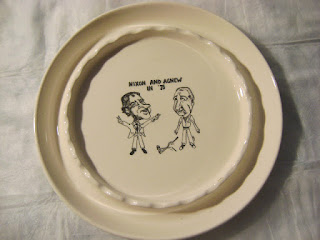Bernheim, born in Germany, emigrated to the United States in 1867 with $4.00 in his pocket. For a while he worked as a peddler, traveling through Pennsylvania on horseback selling household items to housewives. Then his horse died. So he packed up and moved to Paducah, Kentucky, where he went to work in the liquor trade. More important, Isaac met the Uri family, long established Kentucky residents who for years had been in the whiskey business. He married Amanda Uri and in 1872 joined up with her brother, Nathan, in a liquor sales firm called Bernheim Bros. and Uri. (The other Bernheim
 brother was Bernard whom Isaac had brought from Germany).
brother was Bernard whom Isaac had brought from Germany).Because of Paducah’s proximity to large waterways, the business grew rapidly. About 1888, the company bought the Pleasure Ridge Park Distillery and renamed it the Bernheim Distillery Company. About the same time, the Bernheims and Uri moved their business to Louisville, in order to be closer to their distillery. Soon they began the production of an elite whiskey brand called I.W. Harper, a name they had trademarked in 1879.

Within three years of the move, Nathan Uri had left the partnership and in 1893 set up his own firm. called N.M. Uri & Co. The reasons for the split, to my knowledge, have never been adequately explained. Uri bought his own whiskey production facility, the International Distillery at Hunters Station, Kentucky. His principal brand was “Parker Rye” which he advertised nationally. His business flourished as did Bernheim Bros.
Each brother-in-law featured multiple “full metal
 jackets” either to contain or advertise their whiskey. Shown here first are three such items from Bernheim brothers. The Old Harper decanter is labeled “quadruple silver plate.” It carries no maker’s mark but probably was the product of the Homan Silver Plate Company. Founded in 1847, it was located in Cincinnati and produced such silver objects for distilleries, breweries, hotels, restaurants and even riverboat companies.
jackets” either to contain or advertise their whiskey. Shown here first are three such items from Bernheim brothers. The Old Harper decanter is labeled “quadruple silver plate.” It carries no maker’s mark but probably was the product of the Homan Silver Plate Company. Founded in 1847, it was located in Cincinnati and produced such silver objects for distilleries, breweries, hotels, restaurants and even riverboat companies.The two teapots following were made by other companies. The just plain “Harper” teapot was the product of the Taunton Silver Company. During the 19th century, Taunton became known as the "Silver City", as it was home to many silversmithing operations, including Reed & Barton, F.B. Rogers, and Taunton Silver.
The second teapot is marked on the bottom as quadruple silver plate and the product of the Western Silver Metal Company. Brothers-in-law Louis Schnitzer and Nathan Gelfman had both been experienced metalworkers in their homeland of Kiev, Russia. In the early 1920s, they
 were polishing and plating silver at their silver housewares business in New York City called Western Silver Works, Inc. This may have been one of their products.
were polishing and plating silver at their silver housewares business in New York City called Western Silver Works, Inc. This may have been one of their products.Not to be outdone by the Isaac Bernheim, Nathan Uri also produced multiple metal items for his whiskey. The silver decanter marked “Parker Rye” on the base is a Homan-made product. It is marked “Special Metal,” another name for silver soldered silver “quadruple” plate. The whiskey jug that follows mimics the shape of many ceramic jugs of the time. It says “Parker” on one side and “Rye” on the other. It
 is marked quadruple plated with a shamrock logo and “afc co.”
is marked quadruple plated with a shamrock logo and “afc co.” The third container is a whiskey dispenser with a spigot. It presumably could hold a gallon or so of Parker Rye and be ready for the saloonkeeper to turn the handle. Because it was impossible to tell just what these back of the bar items were dispensing, they were banned by law after the repeal of Prohibition.
Uri issued two teapots. The first shown here advertises “R. H. Parker Whiskey.” I personally like the simple but elegant lines of this object. My notes, unfortunately, are silent on its maker. The second teapot, shown in in two views, is once again a Homan product. The base also says that it is warranted quadruple plate, with an additional statement “808 Special H Metal.”
Why are these brothers-in-law each responsible for issuing to
 favored customers these several whiskey metal artifacts? My guess that rivalry between them spurred each to try to outdo the other in providing attractive containers for bar use. Whether Uri was imitating Bernheim or Bernheim was imitating Uri, however, remains undetermined.
favored customers these several whiskey metal artifacts? My guess that rivalry between them spurred each to try to outdo the other in providing attractive containers for bar use. Whether Uri was imitating Bernheim or Bernheim was imitating Uri, however, remains undetermined.











